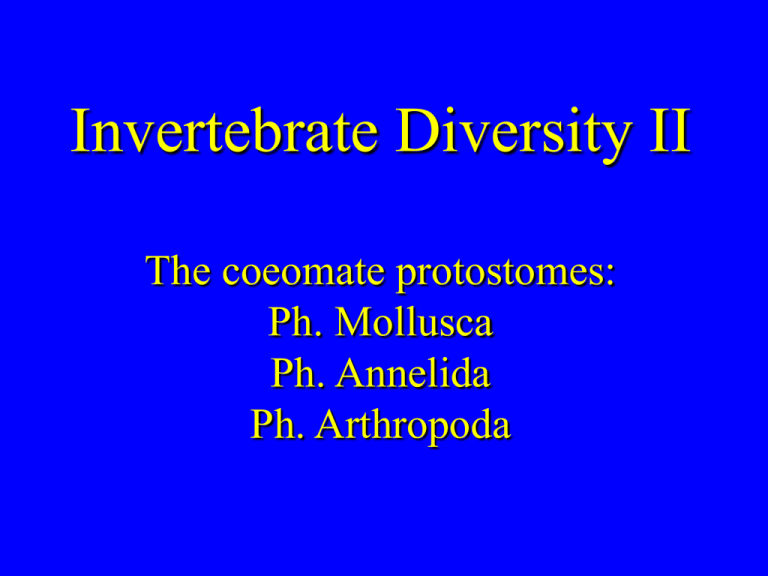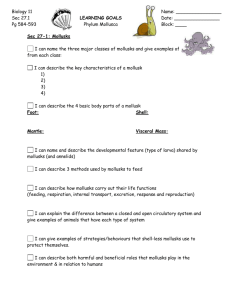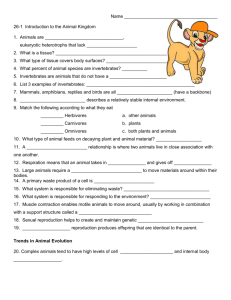Invertebrate Diversity II The coeomate protostomes: Ph. Mollusca Ph. Annelida
advertisement

Invertebrate Diversity II The coeomate protostomes: Ph. Mollusca Ph. Annelida Ph. Arthropoda Body Cavities schizocoely enterocoely Q1: Pseudocoelous animals lack 1) 2) 3) 4) Body symmetry A body cavity A mesodermal cavity lining True tissues Two kinds of coelomates • Protostomes vs. Deuterostomes • Distinguished by their patterns of embryonic development • (Note: developmental patterns are highly conservative, evolutionarily, but may reflect convergent evolution) Protostomes vs. Deuterostomes • Protostome phyla: • Deuterostome phyla: – Mollusca – Annelida – Arthropoda – Echinodermata – Chordata Ph. Mollusca: mollusks • 2nd largest phylum in the Animal kingdom • (e.g., there are more species of terrestrial mollusks than there are vertebrates!) • Body plan -- 3 regions: – ventral muscular foot – visceral mass – mantle -- surrounds internal organs • Radula • Torsion Basic body plan of mollusks The radula • Only in mollusks • Chitinous mouthparts 4 Classes of Mollusks • Cl Polyplacophora -- chitons • Cl. Gastropoda -- snails, slugs, nudibranchs • Cl. Bivalvia -- clams, mussels, oysters . . . • Cl. Cephalopoda -- octopus, squid, cttlefish, nautilus, etc. Cl. Polyplacophora: chitons Lined chiton -- 8 dorsal plates; scrapes algae off rocks Gumboot chiton Cl. Gastropoda Nudibranchs – marine species – shell-less snails Cl. Bivalvia: the bivalves • 2 valves -- shells • filter feeders Q2: Mollusks are 1) 2) 3) 4) Segmented Deuterostomes Pseudocoelomate Schizocoelous Q3: The group of modern mollusks which most closely resembles the ancestral form is 1) 2) 3) 4) Polyplacophora Gastropoda Bivalvia Cephalopoda Cl. Cephalopoda • • • • • • Squid, octopus, nautilus, cuttlefish Nautilus – external shell Cuttlefish – internal shell (the “cuttlebone”) Others have lost shells, evolutionarily Excellent vision, big brains (for inverts!) Good at predicting soccer matches Pacific Giant Octopus 9 foot giant squid (and beak) Cuttlefish and Nautilus Q4: “Cephalopod” means literally 1) 2) 3) 4) Ten-legged Head-foot Stomach-foot Mantle shell Ph. Annelida • • • • Segmented worms Most have septa between segments Allows for controlled movement 3 classes: – Cl. Polychaeta -- polychaetes – Cl. Oligochaeta -- earthworms – Cl. Hirudinea -- leeches Q5: Annelids are: 1) 2) 3) 4) Deuterostomes Schizocoelous Radially symmetrical Triploblastic Cl. Polychaeta Feather Duster Worm Cl. Oligochaeta Cl. Hirudinea (leeches) Q6: Marine annelids belong to Class 1) 2) 3) 4) Hirudinea Polyplacophora Scyphozoa Polychaeta P. Arthropoda: Arthropods • Most species rich phylum on earth! • segmented bodies, but segments fused into tagmata (functional units): head, thorax, abdomen • exoskeleton of chitin • jointed appendages: “Arthro-” + “pod” Q7: Traditional phylogeny regards annelids and arthropods as being closely related because both phyla 1) 2) 3) 4) Have determinate, spiral cleavage Are schizocoelous protostomes Are segmented with ventral, solid nerve chords All of the above 3 sub-phyla in Arthropoda: • Sub-Ph. Chelicerata - - horseshoe crabs, spiders, mites, scorpions • Sub-Ph. Crustacea: crustaceans • Sub-Ph Uniramia: insects, millipedes, centipedes Sub-phyla of Arthropods • Do they have chelicerae? (pincers/fangs) – Sub-ph. Chelicerata -- also no antennae • Or do they have mandibles? (jaws) – Sub-ph. Crustacea • 2 pair antennae; legs biramous – Sub-ph Uniramia • 1 pair antennae; legs uniramous Chelicerae vs. Mandibles Chelicerae Mandibles Arthropod Appendages Biramous Uniramous Chelicerates Limulus Argiope Dust Mite Scorpion Wood Tick Crustaceans Q8: Horseshoe crabs are grouped with spiders rather than true crabs because horseshoe crabs have 1) 2) 3) 4) chelicera eight legs gills antennae 3 classes in Uniramia • Cl .Chilopoda (centipedes) • Cl. Diplopoda (millipedes) • Cl. Insecta (insects) Centipede (Cl. Chilopoda) Millipede (Cl. Diplopoda) Class Insecta Q9: The most speciose class of animals on earth is 1) 2) 3) 4) Insecta Crustacea Bivalvia Oligochaeta Q10: Insects differ from annelids in having 1) 2) 3) 4) A cephalized nervous system A segmented body plan An open circulatory system A pseudocoelom






